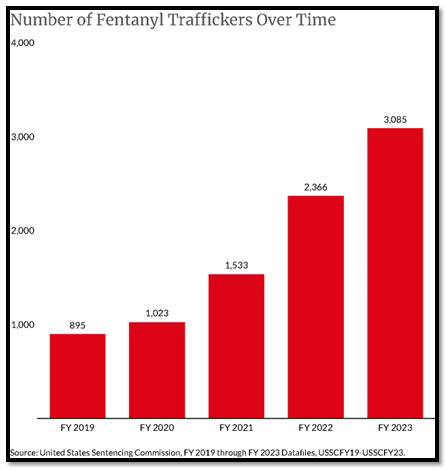Street Drugs and Fentanyl: What You Can Do NOW
Last month, the National Institute of Corrections (NIC) issued a warning about the street drug W-18 and its connection to a wave of synthetic opioid overdoses across the country. There are currently no known drug or urine tests for W-18, which the NIC describes as “100 times more potent than fentanyl and 10,000 times more potent than morphine.” Currently, the NIC recommends the use of naloxone (Narcan) against W-18 and other synthetic opioids. ¹
More and more, street drugs are being cut with fentanyl and other synthetic opioids like xylazine and W-18. Fentanyl drug trafficking is more prevalent than ever, up 245% since 2019.² It is becoming nearly impossible to tell what is in any given street drug that may enter a jail, and we don’t know the long-term effects of these substances. We do know that these drugs may be inhaled or absorbed through the skin and exposure should be avoided.
Take universal precautions
There are a few things you can do now to prevent contact with these substances, starting with taking universal precautions.
Universal precautions are measures used with every detainee to prevent potential exposure.² Many DOJs implemented universal or standard precautions to minimize the spread of COVID-19. Similar actions can be taken in response to increased synthetic drug trafficking.
Frequent hand-washing and disinfecting surfaces are basic universal precautions that a jail should have the resources to implement right away. Officers should wash their hands and wipe down surfaces as often as possible during and after shifts.
Since you may not know who or what materials have come into contact with a synthetic drug, precautions should be used throughout the cell block and in interactions with detainees. Take universal precautions.
Complete drug testing at intake
Drugs may be trafficked into jails in body cavities. This may lead to overdose when the bag bursts inside the person’s body or cause future overdoses after other detainees are exposed to the substance. If a site does not have a body scanner, drug testing at intake may be a reasonable alternative to prevent drugs from entering the jail. Although not currently approved by the FDA for medical purposes, fentanyl test strips can be used in jail as a forensic screening tool during booking. Complete drug testing at intake.
Use naloxone and call 911
While there is currently no known treatment for W-18, many street drugs are combined with non-synthetic or conventional opioids. For this reason, administer naloxone as soon as overdose is suspected. Naloxone will not harm the victim, even if they are not overdosing. It is common for multiple doses to be appropriate.¹ Naloxone may stabilize a victim, but it should not be used as a standalone treatment. Call 911 after administering naloxone. Since street drugs may have multiple different chemicals in them, further medical care and stabilization may be appropriate. Use naloxone and call 911.
For more information, please contact training@sparktraining.us.
National Institute of Corrections (2024). “Corrections Health Alert W-18,” NIC.gov. https://nicic.gov/resources/resources-topics-and-roles/topics/correctional-healthcare.
United States Sentencing Commission (2023), “Fentanyl Trafficking,” FY 2019 through FY 2023 Datafiles, USSCFY19-USSCFY23. USSC. https://www.ussc.gov/research/quick-facts/fentanyl-trafficking#_ftnref3
Alabama A&M (2023). “Universal Precautions,” AAMU.edu. https://www.aamu.edu/academics/colleges/education-humanities-behavioral-sciences/departments/health-sciences-human-performance-communicative-disorders/communicative-sciences-disorders/_documents/universalprecautions.pdf.
Disclaimer
All materials have been prepared for general information purposes only. The information presented should be treated as guidelines, not rules. The information presented is not intended to establish a standard of medical care and is not a substitute for common sense. The information presented is not legal advice, is not to be acted on as such, may not be current, and is subject to change without notice. Each situation should be addressed on a case-by-case basis.
When in doubt, send them out!®






















